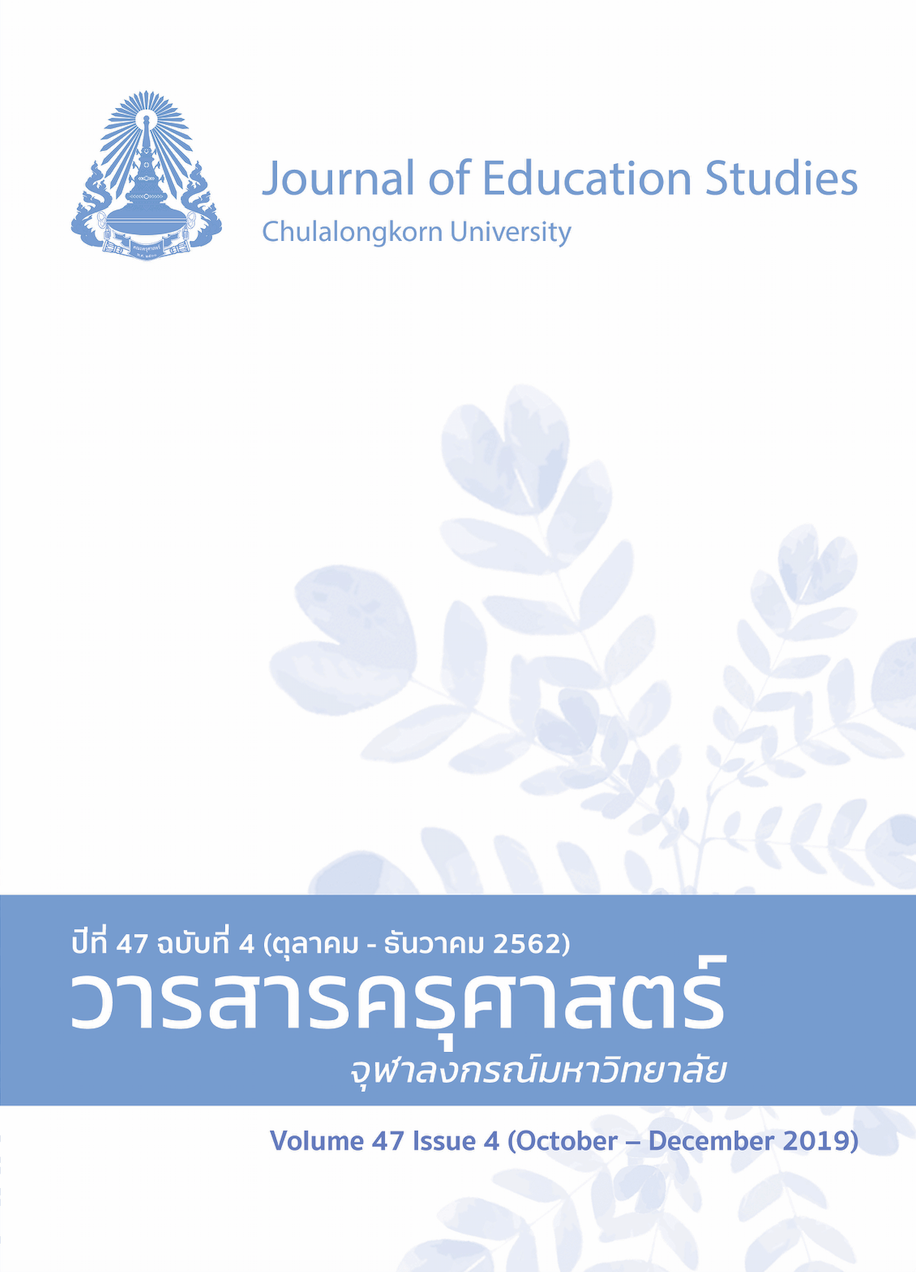Development of an Instructional Process Based on Mathematical Modeling and Scaffolding Approaches to Enhance Mathematical Problem Solving and Representation Abilities of Lower Secondary School Students
Keywords:
MATHEMATICAL PROBLEM SOLVING, MATHEMATICAL REPRESENTATION, MATHEMATICAL MODELING, SCAFFOLDINGAbstract
The objectives of this research were 1) to develop instructional process based on mathematical modeling and scaffolding approaches and 2) to study the quality of instructional process based on mathematical modeling and scaffolding approaches. The target group were 7th to 9th graders in demonstration schools under the Office of the Higher Education Commission (OHEC) within Bangkok. Samples composed of 64 Mathayom 2 (the 8th grade) students from Chulalongkorn University Demonstration School: 32 in the experimental group and 32 in the control group. The experimental time were 24 periods of class in 12 weeks. There are 2 stages in the process, namely 1) development of instructional process based on mathematical modeling and scaffolding approaches 2) experiment of the teaching process. Research tools were the mathematical problem solving ability test and the mathematical representation ability test. Data were analysis by using arithmetic mean, standard deviation and t-test.
The findings were as follows:
- The developed instructional process comprised of 5 steps: 1) proposing problems of interest, 2) determining the target and creating mathematical modeling, 3) solving the problem and referring the results to the real world environment, 4) evaluating the model and verifying the model, 5) extending the idea to new situations.
- After the experiment, the experimental group had higher problem solving ability and mathematical representation ability than those of the control group at .05 significant level.
References
โครงการ PISA ประเทศไทย. (2554). ผลการประเมิน PISA 2009 การอ่านคณิตศาสตร์และวิทยาศาสตร์: บทสรุปเพื่อการบริหาร. สืบค้นจาก https://pisathailand.ipst.ac.th/isbn-9786167235141/
จิรายุส สมานมิตร. (2555). การศึกษาปัจจัยบางประการที่ส่งผลต่อความสามารถในการแก้โจทย์ ปัญหาทางคณิตศาสตร์ของนักเรียนชั้นมัธยมศึกษาปีที่ 3 สังกัด สำนักงานเขตพื้นที่การศึกษาประถมศึกษานครปฐมเขต 1 (วิทยานิพนธ์ปริญญามหาบัณฑิต ไม่ได้ตีพิมพ์). มหาวิทยาลัยศรีนครินทรวิโรฒ, กรุงเทพฯ.
ชลธิชา ใจพนัส, อรอุมา เจริญสุข, และ วิไลลักษณ์ ลังกา. (2556). ปัจจัยบางประการที่ส่งผลต่อความสามารถในการแก้โจทย์ปัญหาคณิตศาสตร์ของนักเรียนชั้นมัธยมศึกษาปีที่ 1 โรงเรียนสาธิตมหาวิทยาลัยศรีนครินทรวิโรฒ. วารสารวิชาการ Veridian E-Journal, 6(3), 286-304.
พินิจ ศรีจันทร์ดี. (2530). องค์ประกอบบางประการที่สัมพันธ์ต่อผลสัมฤทธิ์ในการเรียนคณิตศาสตร์ของนักเรียนชั้นมัธยมศึกษาปีที่ 1 โรงเรียนสาธิตมหาวิทยาลัยรามคำแหง (รายงานวิจัย). คณะกรรมการส่งเสริมการวิจัย มหาวิทยาลัยรามคำแหง, กรุงเทพฯ.
ไมตรี อินทร์ประสิทธิ์ และ คณะ. (2544). กระบวนการแก้ปัญหาคณิตศาสตร์กรณีศึกษานักเรียนชั้นมัธยมศึกษาตอนต้น (รายงานวิจัย). คณะศึกษาศาสตร์ มหาวิทยาลัยขอนแก่น, ขอนแก่น.
วัฒนิตา นำแสงวานิช. (2539). ผลของการแก้ไขข้อบกพร่องที่เป็นพื้นฐานทางคณิตศาสตร์ เรื่อง เศษส่วน ของนักเรียนชั้นมัธยมศึกษาปีที่ 1 โดยการใช้แบบฝึกทักษะ (วิทยานิพนธ์ปริญญามหาบัณฑิต ไม่ได้ตีพิมพ์). จุฬาลงกรณ์มหาวิทยาลัย, กรุงเทพฯ.
โศจิวัจน์ เสริฐศรี. (2553). การพัฒนากระบวนการเรียนการสอนโดยใช้แนวคิดการคิดเชิงสัมพันธ์และแนวคิดการเสริมต่อการเรียนรู้เพื่อเสริมสร้างความสามารถในการให้เหตุผลเชิงพีชคณิตของนักเรียนประถมศึกษา (วิทยานิพนธ์ปริญญาดุษฏีบัณฑิต ไม่ได้ตีพิมพ์). จุฬาลงกรณ์มหาวิทยาลัย, กรุงเทพฯ.
สำนักงานเลขาธิการสภาการศึกษา. (2553). แผนการศึกษาแห่งชาติ ฉบับปรับปรุง (พ.ศ. 2552-2559). กรุงเทพฯ: พริกหวานกราฟฟิค.
สำนักงานเลขาธิการสภาการศึกษา. (2557). สภาวการณ์การศึกษาไทยในเวทีโลก ปี 2557. กรุงเทพฯ: พริกหวานกราฟฟิค.
อัมพร ม้าคนอง. (2536). การวินิจฉัยข้อผิดพลาดทางการเรียนคณิตศาสตร์ของนักเรียนชั้นมัธยมศึกษาปีที่ 5 โรงเรียนสาธิตจุฬาลงกรณ์มหาวิทยาลัย (รายงานผลการวิจัย). กรุงเทพฯ: คณะครุศาสตร์ จุฬาลงกรณ์มหาวิทยาลัย.
ภาษาอังกฤษ
Been, A. L. (2016). Teacher views of mathematical modeling. Tucson, AZ: The University of Arizona.
Blum, W., & Ferri, R. B. (2009). Mathematical modelling: Can it be taught and learnt?. Journal of Mathematical Modelling and Application, 1(1), 45-58.
Blum, W., & Niss, M. (1991). Applied mathematical problem solving, modeling, applications, and links to other subjects-state, trends and issues in mathematics instruction. Educational studies in Mathematics, 22(1), 37-68.
Bolden, D., Barmby, P., & Harries, T. (2013). A representational approach to developing primary ITT students’ confidence in their mathematics. International Journal of Mathematical Education in Science and Technology, 44(1), 70-83.
Cai, J., & Lester, F. (2010). Why is teaching with problem solving important to student learning. Retrieved from https://www.nctm.org/uploadedFiles/Research_and_Advocacy/research_brief_and_clips/Research_brief_14_-_Problem_Solving.pdf
Cifarelli, V. V. (1998). The development of mental representations as a problem solving activity. The Journal of Mathematical Behavior, 17(2), 239-264.
English, L., & Lesh, R. (2003). Ends-in-view problems. In R. Lesh & H. M. Doerr (Eds.), Beyond constructivism: Models and modeling perspectives on mathematics problem solving, learning, and teaching (pp. 297-316). Mahwah, NJ: Lawrence Erlbaum Associates.
Greeno, J. G., & Hall, R. B. (1997). Practicing representation: Learning with and about representational forms. Phi Delta Kappan, 79, 361-367.
Harries, T., & Barmby, P. (2011). The importance of using representations to help primary pupils give meaning to numerical concepts. Retrieved from https://directorymathsed.net/download/Harris.pdf
Kaput, J. J. (2002). Notations and representations as mediators of constructive processes. In E. V. Glasersfeld (Ed.), Radical constructivism in mathematics education (pp. 53-74). Dordrecht: Springer.
Kingsdorf, S., & Krawec, J. (2014). Error analysis of mathematical word problem solving across students with and without learning disabilities. Learning Disabilities Research & Practice, 29(2), 66–74.
Krulik, S., & Reys, R. E. (1980). Problem solving in school mathematics: 1980 yearbook. Reston, VA: National Council of Teachers of Mathematics.
Lesh, R., Landau, M., & Hamilton, E. (1983). Conceptual models in applied mathematical problem solving. In R. Lesh (Ed.), The acquisition of mathematical concepts and processes. New York: Academic.
Machmud, T. (2011). Scaffolding strategy. In mathematics learning. In Proceeding international seminar and the fourth national conference on mathematics education (pp. 429-440). Yogyakarta: Department of Mathematics Education, Yogyakarta State University.
National Council of Teachers of Mathematics [NCTM]. (2000). Principles and standards for school mathematics: National council of teachers of mathematics. Reston, VA: National Council of Teachers of Mathematics.
Paivio, A. (1969). Mental imagery in associative learning and memory. Psychological Review, 76(3), 241-263.
Slavin, R. E., & Davis, N. (2006). Educational psychology: Theory and practice (8th ed.). Boston: Pearson/Allyn & Bacon.
Uzun, S. Ç., & Arslan, S. (2009). Semiotic representations skills of prospective elementary teachers related to mathematical concepts. Procedia-Social and Behavioral Sciences, 1(1), 741-745.




